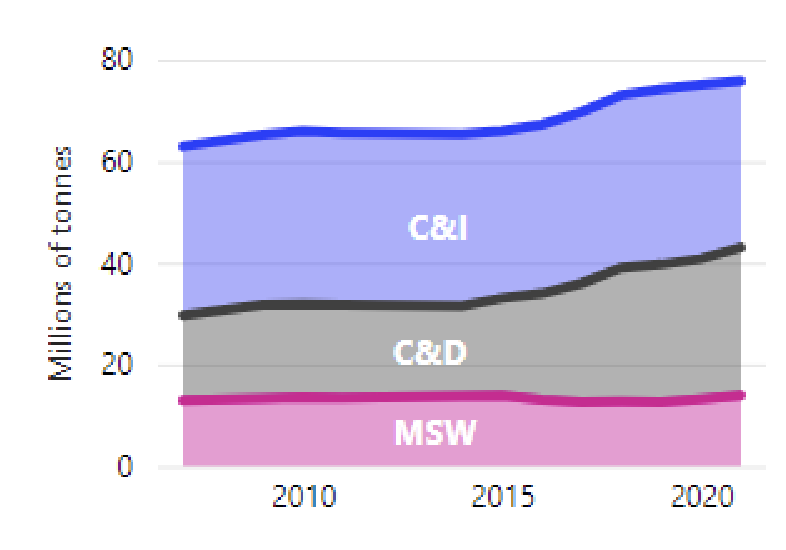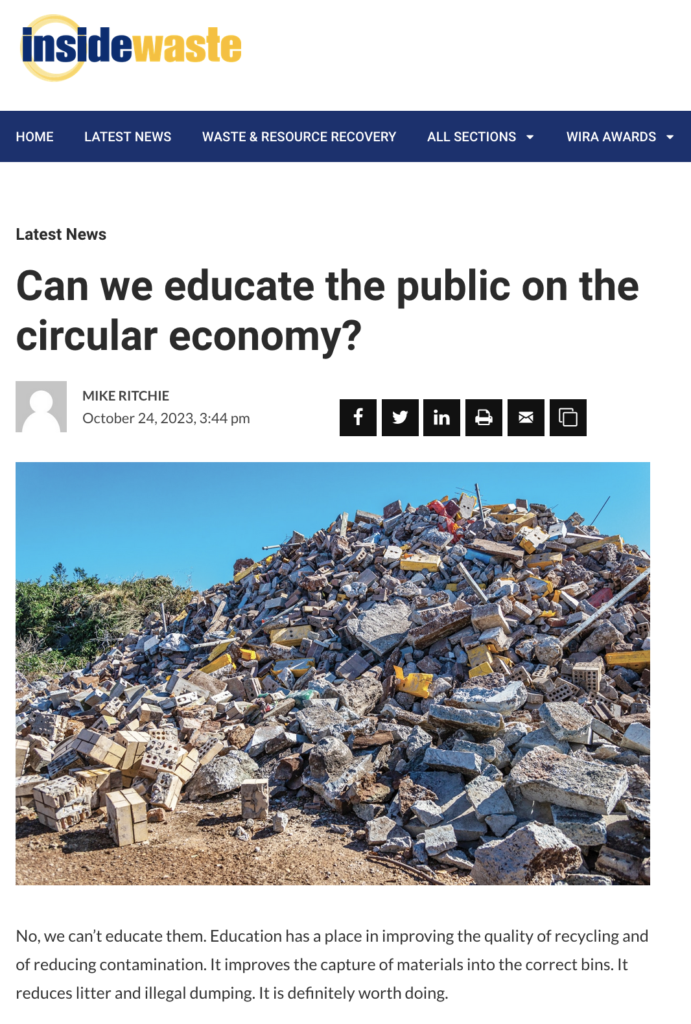Waste myth #8: We can educate the community to achieve a circular economy

By Mike Ritchie, Director, MRA Consulting Group
We can’t.
Education has a place in improving the quality of recycling and of reducing contamination. It improves the capture of materials into the correct bins. It reduces litter and illegal dumping. It is definitely worth doing.
BUT it is not a mechanism that can deliver the additional 18 MT of recycling needed to achieve the national waste targets of 80% diversion from landfill by 2030.
And I am just pitching for 80% and setting aside the aspiration for a Circular Economy at this time, which implies a 100% or near 100% recycling and diversion from landfill.
Education is not a mechanism that can deliver those sorts of tonnages.
Tweet
Here are some facts:
- Australia generates 67MT of waste.
- We recycle 40 MT.
- We landfill 27MT or 40%.
- To achieve an 80% diversion rate we need to grow total recycling by 18 MT/year or cumulatively increase it by 2MT per year every year for the next 8 years to 2030.
- Kerbside recycling represents 1.9MT/yr.
- Achieving the national waste targets is about a lot more than kerbside recycling.
I don’t mean to diminish the role of education, but I do want to say that education works best when it is aligned with commercial incentives rather than in opposition to them.
Education is a weak instrument compared to price.
Tweet
Most often when price drives material to landfill, all the education in the world will not reverse the trend, nor in fact, have much impact on it at all.
Let’s look at Commercial Food Organics (COFO) as an example.
It is currently cheaper to landfill almost all COFO than to separate it, collect it and redirect it to composting or anaerobic digestion. That is because it is hard to keep it clean enough. There are relatively fewer COFO generators than waste generators which makes collection comparatively more expensive (tonnes collected per truck hour) and the differential in gate fees between landfill and composting/AD is insufficient to bridge the gap.
That is why 80% of COFO waste is landfilled across Australia.
Now, let’s assume some generous EPA ran a program to educate business owners on the downsides of landfilling COFO, both in terms of greenhouse emissions and the waste of resources.
A rational business owner will weigh up their commercial interests vs those of the broader society.

It would be no surprise to you that over 95% of business owners will opt for the cheaper option of landfill disposal.
AND it doesn’t matter how many times you visit that business to educate and inform, the economics have not changed.
Business generates 70% of the waste in Australia.
To achieve a Circular Economy or even the 80% waste targets, we must use instruments that help/convince businesses to act.
There are few of those available and these fall into two categories:
- Regulation
- Mandated separation and collection of materials such as organics;
- Extended Producer Responsibility mandating the producers of materials take responsibility for their end of life use/recycling;
- Bans on materials to landfill (Europe has been doing this for decades);
- Limits of greenhouse emissions which will drive recycling (watch this space for the Safeguard Mechanism’s impact); and
- Other.
- Price
- Landfill levies;
- Subsidies for recycling (e.g. EPA grants often derived from landfill levies);
- Tax incentives for recycling or diversion from landfill e.g. differential tax regimes or GST rebates; and
- Other.
While I am a big supporter of education to drive capture of recyclables, it works best when the systems are already in place and we are using education to drive behaviour to those systems. It is a weak instrument in getting the systems set up in the first place.
For example, education works well in getting businesses/households to do better recycling of say cardboard. But it is not the reason we have cardboard recycling per se. We have cardboard recycling because Councils save money recycling it rather than landfilling it and businesses earn money by recycling it rather than paying to have it collected and landfilled.
This is true of most waste streams.
So to summarise, we cannot educate our way to a Circular Economy. We need to use regulation and price signals.
Governments love education because there is no risk in educating the public.
Regulation and price involve risk.
Governments need to step up if we are going to have any chance of achieving the Targets.
Mike Ritchie is the Managing Director at MRA Consulting Group.
This article has been published by the following media outlets:




